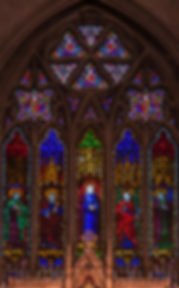
A History of St Marks, Worsley
The Patron
The Patron of St Mark's Church, Worsley, was Francis Leveson-Gower who later took the title Lord Francis Egerton, heir of the Duke of Bridgewater (The Canal Duke). He was born on the first day of the century, 1st January 1800, and became the 1st Earl of Ellesmere and Viscount Brackley in 1846, the week the church was consecrated.
In 1833, when he succeeded his father (George Granville Leveson-Gower,1st Duke Of Sutherland) as a beneficiary of the Bridgewater Trust and moved to Worsley, he described the place as "A God-forgotten place, its inhabitants much addicted to drink and rude sports, their morals deplorably low"

The whole district was in a state of religious and educational destitution, there was no one to see to the spiritual wants of the people and teaching was all but nullity itself.
As well as the church, he provided the village with many other facilities, including a reading room.
The Foundation Stone was laid on 15 June 1844 by Lord Egerton's eldest son George Granville Francis on the occasion of his 21st birthday. In the cavity of the stone specimen coins of each denomination were placed
The Church building was completed and consecrated on 2 July 1846 by The Rt Rev John Bird Sumner, Bishop of Chester – the year before the new diocese of Manchester was created. In fact, at the consecration, the tower and steeple were not quite finished, and the stained glass windows had not yet been acquired.
The Site
A commanding site of 10,403 acres was chosen, known as Cross Field, taking its name from the Travellers’ or Our Lady’s Cross which formerly stood at the junction of Leigh and Walkden Roads. It appears on 18th-century maps and was probably a travellers’ cross
Later that century, the Duke of Bridgewater and his agent/engineer John Gilbert built a lead pencil manufactory on the site - the vaulting in the cellar of what is now the Rectory, which was built in 1850 and originally known as Crossfield House, may be a relic of this (John Gilbert has received belated recognition with the naming of a new pub opposite the church - at which the Rector pulled the first pint.)
The church dominated the rural landscape then, as it does the motorway network now.
The Architect
The Architect was Sir George Gilbert Scott (1811-78), one of the most prolific architects of the Victorian era – 740 new or restored buildings, including 470 churches!
He was the first in the family line of architects who have given us buildings as diverse as St Pancras Station, Liverpool Anglican Cathedral and Battersea Power Station (now the Tate Modern)
In Scott’s own words, "I have become one of the leading actors in the greatest architectural movement which has occurred since the Renaissance". He was referring to the Gothic Revival of which St Mark, Worsley is an early and particularly fine example

Prior to the designing of St Mark, Worsley at the age of 33, Scott and his partner W.B. Moffat (with whom he parted company in 1845) had designed mainly workhouses and lunatic asylums, cashing in on the requirements of the new Poor Law Act, and a few rather dull churches which paid scant regard to liturgical principles (though his father was an Anglican clergyman).
It was his European travels in this period that changed his perspective of the church building. The subject of church design was to become popular with both clergy and lay people and much-debated by the Victorians, who saw a moral purpose in returning to medieval forms of art and architecture which they believed to be the purest setting for Christian worship. The Decorated period of the late thirteenth and early fourteenth centuries came to provide the preferred style - this is the most ornate of Gothic forms
Of the many churches, Scott designed, St Mark, is perhaps the purest in form. Although he barely mentions it in his autobiography, his grandson Sir Giles (the architect of Liverpool Anglican Cathedral) is reported to have said he considered it to be the best of his works of art.
Given that tenders for such an elaborate building were still under consideration in April 1844, to complete it in two years , George Evans, Scott's Foreman of Works, must have had an army of workers and craftsmen at his disposal. (Some of these moved on to build St Paul’s Walkden, up to the road, at a lower rate of pay – hence its Victorian nickname t’ drop church).
Sir George Scott was a man of phenomenal energy, influence and success. He died in 1878 and was buried in Westminster Abbey, an honour given to no other architect before or since.
The Building
The exterior is modelled on an English parish church of circa 1300 and has fine carved stonework. Externally the spire has small flying buttresses and its pinnacles, gabled openings and buttresses are richly embellished with crockets and crosses. There are numerous carved gargoyles to the exterior of the building.
Visitors are sometimes surprised that what is outwardly such an imposing church (it cost £20,000 to build) has an intimate feel within.
